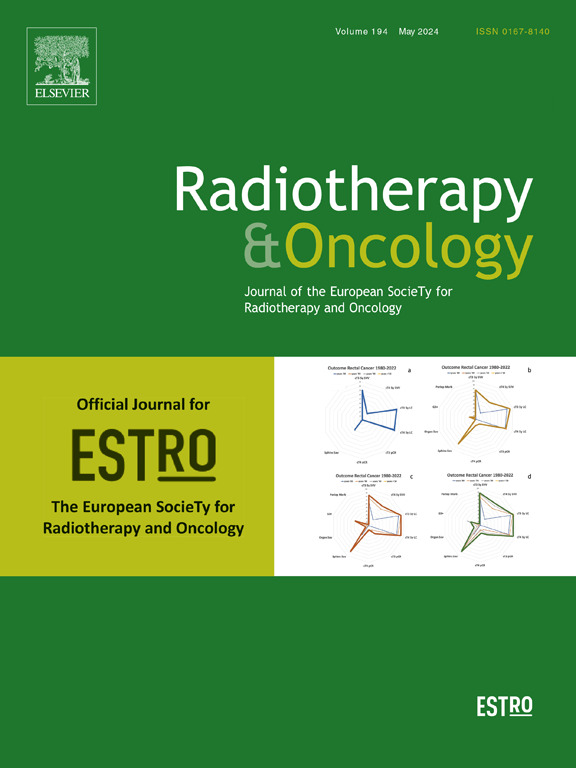A comprehensive mechanistic study on the proton FLASH sparing effect in zebrafish embryos: From DNA damage to developmental abnormalities
IF 4.9
1区 医学
Q1 ONCOLOGY
引用次数: 0
Abstract
Background and purpose
Ultra-high dose rate (UHDR) irradiation induces less normal tissues toxicities compared to conventional dose rate (CONV) irradiation. We aimed to assess whether UHDR and CONV proton irradiation result in different levels of DNA damage in zebrafish embryos. Moreover, we studied the downstream transcriptional activation and functional changes following both modalities.
Materials and methods
Zebrafish embryos received 30 Gy UHDR (>5100 Gy/s) or CONV (0.18 Gy/s) proton irradiation at 28 h post-fertilization on a 68 MeV cyclotron. DNA damage was assessed at 4 h post-irradiation. Gene expression changes were assessed at 6 and 24 h post-irradiation. Apoptosis, proliferation and neutrophil migration were investigated at 6 h and 20 h post-irradiation. Survival and morphological abnormalities were assessed at 4 days post-irradiation.
Results
No significant differences in morphological abnormalities were found between treatment groups. Conversely, significantly higher levels of DNA damage were observed in CONV- versus UHDR-irradiated embryos. CONV irradiation resulted in higher expression levels of genes involved in cell cycle arrest (cdkn1a) and p53 regulation (mdm2). Lastly, CONV irradiation resulted in higher levels of apoptosis in the embryonic tail compared to UHDR irradiation. Comparable cell proliferation and neutrophil migration to the sites of injury was found between treatments.
Conclusion
UHDR proton irradiation induces less DNA damage and less downstream transcriptional activation of DNA damage response pathways in zebrafish embryos compared to CONV irradiation, resulting in reduced embryonic cell death. However, the magnitude of observed differences might not always be high enough to translate into significant differences in developmental abnormalities.
斑马鱼胚胎中质子FLASH保留效应的综合机制研究:从DNA损伤到发育异常。
背景与目的:与常规剂量率(CONV)照射相比,超高剂量率(UHDR)照射对正常组织的毒性较小。我们的目的是评估UHDR和CONV质子辐照是否会导致斑马鱼胚胎不同程度的DNA损伤。此外,我们还研究了两种模式下的下游转录激活和功能变化。材料和方法:斑马鱼胚胎,受精后28 h在68 MeV回旋加速器上接受30 Gy UHDR (bb0 5100 Gy/s)或CONV(0.18 Gy/s)质子照射。辐照后4 h评估DNA损伤。在照射后6 h和24 h评估基因表达变化。在照射后6 h和20 h观察细胞凋亡、增殖和中性粒细胞迁移。照射后4 天评估存活和形态学异常。结果:两组间形态学异常无明显差异。相反,与uhdr相比,在CONV辐照的胚胎中观察到明显更高水平的DNA损伤。CONV照射导致参与细胞周期阻滞(cdkn1a)和p53调控(mdm2)的基因表达水平升高。最后,与UHDR照射相比,CONV照射导致胚胎尾部的细胞凋亡水平更高。在两种治疗之间发现了类似的增殖和中性粒细胞向损伤部位的迁移。结论:与CONV辐照相比,UHDR质子辐照对斑马鱼胚胎的DNA损伤和下游DNA损伤反应通路的转录激活更小,从而减少了胚胎细胞的死亡。然而,观察到的差异的幅度可能并不总是高到足以转化为发育异常的显著差异。
本文章由计算机程序翻译,如有差异,请以英文原文为准。
求助全文
约1分钟内获得全文
求助全文
来源期刊

Radiotherapy and Oncology
医学-核医学
CiteScore
10.30
自引率
10.50%
发文量
2445
审稿时长
45 days
期刊介绍:
Radiotherapy and Oncology publishes papers describing original research as well as review articles. It covers areas of interest relating to radiation oncology. This includes: clinical radiotherapy, combined modality treatment, translational studies, epidemiological outcomes, imaging, dosimetry, and radiation therapy planning, experimental work in radiobiology, chemobiology, hyperthermia and tumour biology, as well as data science in radiation oncology and physics aspects relevant to oncology.Papers on more general aspects of interest to the radiation oncologist including chemotherapy, surgery and immunology are also published.
 求助内容:
求助内容: 应助结果提醒方式:
应助结果提醒方式:


